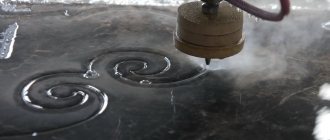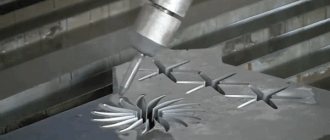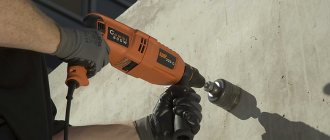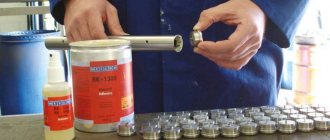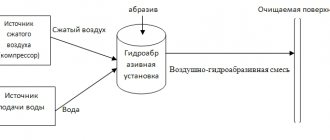— how the process is carried out if you need to cut a hole in glass under water
— is it possible to make the procedure safe if you cut glass by placing it in water
— rules and recommendations on how to cut glass in water using scissors
— what scissors are used to cut a glass surface surrounded by water — we’ll help answer common questions
— help and answers to related questions, how this method works, what effect is achieved
— cutting glass underwater with scissors video
How to cut glass without a glass cutter
Before we begin a detailed description of glass cutting techniques, we would like to remind you about safety. Always wear work gloves and safety glasses while working to avoid cuts and small debris getting into your eyes. Be careful not to apply excessive pressure to the glass.
Burning thread
A very common method, mainly used for cutting glass bottles. Straight glass can also be cut using this method, but with minor nuances. All that is needed to make an even glass chip is a piece of woolen thread, a flammable liquid (alcohol, kerosene, etc.) and a container of cold water.
We soak the thread in a flammable liquid and fix it on the glass along the cut line.
We set it on fire, wait for it to burn completely and immediately place it in cold water or pour it onto the heating site. The main thing is that the glass cools down as quickly as possible and bursts due to temperature changes. A characteristic click will signal the success of the work done. If the glass does not crack, you can try repeating the operation. This method breaks bottles fairly smoothly, but does not always work with large glass sizes. It is also very fire hazardous and requires a fire extinguisher or a container of water on hand, which is already required.
Soldering iron
A very interesting, but rather slow method of thermal cutting of glass. It is more suitable for curly cutting, but it will also make a regular straight line without any problems. For this operation you will need a file and a heating element (soldering iron or burning machine).
Having marked the line of the future cut on the glass, take a file and make a small groove with it from the very edge. Having retreated 1-2 mm from it, we heat the place with a soldering iron until a microcrack forms between it and the mark. Next, we retreat from the crack itself to the same distance and gradually move towards the finish point. This takes a long time to cut glass, but you can get any shape. To speed up the process slightly, the glass can be periodically cooled by applying a damp cloth to it.
Scissors in water
A simple method of directional chipping of glass. Allows you to easily cut out round shapes, but is not suitable for creating straight lines. For such cutting, you will need ordinary scissors and a container of water, which will serve as a kind of lubricant. The maximum glass thickness should not exceed 4 mm.
The cutting process using this technique is extremely simple. We take a piece of glass to be processed, immerse it in water and break off small pieces from the edges with scissors. Water will prevent the glass from cracking, allowing you to make a controlled chip. In this way you can get oval and round shapes.
Diamond blade
Not the safest way to cut glass, requiring increased care and mandatory compliance with safety rules. It can easily break glass and throw a fragment in any direction. Otherwise, the method is quite effective and can cope with the task. For cutting, you will need a special tool (grinder, drill or drill) with a diamond disk 0.1 mm thick. The cutting process itself is quite simple, but it requires some skill and a steady hand to guide the tool clearly along the line. We place the piece of glass to be processed on a flat place, then take a cutter and draw a line on the surface of the glass with a disk. The main thing is not to dive deep, but only lightly touch it so that a small hollow is formed, similar to a wide line from a glass cutter. Next, we simply break the glass in the right place. To reduce the likelihood of glass chipping and reduce the amount of glass dust while working, you can periodically water the cutting area with water.
File
Another way to cut glass at home without a glass cutter or expensive power tools. To work, you will need a file and a little experience in handling glass. Please note that the file must have corners, so a round one will not work.
To cut glass, it is enough to make several cuts on its surface with the corner of a file.
You need to apply a little more pressure on the file than average so that the force is enough to form a clear groove, similar to the cut of a glass cutter. When the place of the chip is marked, we simply break the glass on the edge of the table or by placing a match under the place of the cut. This method requires a certain skill, and if you are faced with cutting glass for the first time, we strongly recommend that you practice on small, unnecessary fragments before moving on to the main material.
Pobedit drill
If you know first-hand what glass cutting is, then we suggest considering another way to cut glass without a glass cutter. If you have some experience, one drill with a Pobedit tip may be sufficient for this operation. The main thing is that the drill is more or less new, with sharp corners on the head.
The process of cutting glass with a drill is in many ways similar to a conventional roller glass cutter.
The differences include a higher pressure force, but otherwise all actions are standard. We lay the glass on a flat surface, mark the cutting line, apply a bar, and draw a line along it from top to bottom. Before cutting, rotate the tip so that the sharpest angle makes contact with the glass. Having received a clear line, we break the glass along the cutting line. The method of cutting glass with a Pobedit drill requires skill and practical experience in handling this material. Beginning craftsmen have very little chance of making an accurate cut using this method, but with patience and straight hands, the desired result can be obtained.
Compliance with safety regulations
To avoid injury, you should work with gloves. Pay attention to shoes that should be durable so that accidental glass does not cut your feet. It is necessary to dress in thick overalls made of thick fabric.
Sources
- https://vopros-remont.ru/obshhie-voprosy/kak-rezat-steklo-pravilno-uchimsya-rezke-svoimi-rukami/
- https://stroypomochnik.ru/kak-rezat-steklorezom-01/
- https://domsdelat.ru/instrumenty/kak-pravilno-rezat-steklo-v-domashnix-usloviyax.html
- https://HouseDiz.ru/kak-prosto-rezat-steklo-v-domashnix-usloviyax-svoimi-rukami-steklorezom/
- https://FB.ru/article/264894/kak-otrezat-steklo-bez-stekloreza-poshagovaya-instruktsiya-sposobyi-i-rekomendatsii
- https://setafi.com/lajfhaki/kak-bez-stekloreza-razrezat-steklo-v-domashnih-usloviyah/
- https://2lzz.ru/ruchnoj-instrument/steklorez/7-sposobov-kak-bez-stekloreza-razrezat-steklo
- https://izobreteniya.net/kak-razrezat-steklo-bez-stekloreza/
Cutting with scissors
In addition to a glass cutter, scissors can also be used to cut glass. But this also needs to be done correctly. To work you will need:
- the scissors themselves, it’s better to take sewing ones;
- a tank with (preferably) hot water.
As in the previous case, apply markings to the glass in advance. During the work process, when cutting with scissors, a microcrack is created, and in the end everything ends with a capillary effect. This is all elementary physics.
The result obtained, of course, will not be ideal, but if there is a need to do something urgently, then this cutting method will do.
The most effective method
It is more correct and efficient to cut with a conventional glass cutter. It can be indispensable if you decide to make a dressing table yourself, or to restore old mirrors to decorate the interior of your own home.
The advantages of special tools are that with their help you can easily cut out even quite complex elements, process a thick mirror and set the desired shape of the canvas.
When purchasing a glass cutter, be sure to pay attention to its type. The tool can be roller or diamond. The first one is more budget-friendly, but has lower accuracy, quality and cutting speed. Diamond glass cutters are expensive, but with frequent use, the investment will be fully worth it.
Household roller glass cutter
It won’t take much time to learn how to properly operate such a device. By following certain rules, you will be able to achieve the desired result:
- The glass cutter must be held at a right angle, but a slight deviation is allowed;
- pressing with the index finger, the instrument is firmly fixed with the middle and thumb;
- while moving along the blade, you cannot change the position of the cutter;
- it is extremely important to make the cut with a quick and confident movement;
- It is not recommended to make a second cut along the same line;
- a strictly uniform force is applied, but except at the edges;
- when approaching the edge approximately 5 mm before the edge, you need to reduce the load on the glass cutter;
- the cut is made from the far point towards you;
- a high-quality cut is obtained in a dark color in the case of a roller tool;
- Diamond cutters always leave behind a light, thin strip;
- It is not recommended to deepen poorly executed cuts, but it is better to step back a little and make a new one.
As you can see, there are quite a lot of nuances. But they can cause some difficulties only during the first attempts to cut the mirror cloth yourself. With a little practice, everything will start to work out quickly and efficiently.
Diamond glass cutter head
Features of working with non-standard glass
Tempered glass cannot be processed at home; when mechanical stress is applied to it, it crumbles or breaks into pieces. Corrugated glass is cut with a glass cutter in the same way as regular glass, but on the smooth side.
Corrugated glass is cut on the straight side
Acrylic glass is not actually glass. Thin material is cut using simple scissors or an ordinary knife. A thick sheet can be drawn along a ruler with a piece of a hacksaw blade, several times, and then bent and broken along the mowing line.
Scope of application of abrasive materials
| Name | Typical Applications |
| Garnet sand (consists of corundum Al2O3, quartz sand SiO2, iron oxide Fe2O3 and other components) | Widely used for cutting various materials, especially high-alloy steels and titanium alloys |
| Electrocorundum grains (consists mainly of Al2O3 corundum, as well as impurities) or its varieties | Man-made materials with very high Mohs hardness. Used for cutting steel, aluminum, titanium, reinforced concrete, granite and other materials |
| Silicon carbide (SiC) grains – green or black | |
| Quartz sand (SiO2) | Glass cutting |
| Silicate slag particles | Cutting plastic reinforced with glass or carbon fibers |
Sequence of procedure
Some cut an old, previously glued mirror, while others use new canvases. But regardless of this, cutting requires mandatory preliminary preparation, as well as correct execution of the procedure. Only then will you choose the method of attaching the mirrors, or select the appropriate glue for the mirror to fix it.
If we consider the process step by step, it involves the following steps:
- First you need to prepare a flat surface of appropriate size. Often this is done simply on the floor, but it is better on the table. The canvas is laid face up;
- Be sure to place a soft lining under the mirror so as not to damage it when pressed;
- The surface is cleaned with a soda solution and then with alcohol;
- All irregularities on the reverse side should also be removed and leveled;
- At the next stage, markings are applied. The line should run 2 mm further than the future cut, since finishing is still to be done;
- Using a ruler to control the straight cutting stroke, a glass cutter is used;
- After making the cut, the mirror is moved to the edge of the table and hangs out a little. The cut part is carefully separated;
- You can remove excess after a cut with gloved hands, a rubber hammer, or pliers with plastic (rubber) pads;
- Using fine-grained sandpaper, process the sections.
Working with a glass cutter
That's it, now you have managed to cut out the required element. What to do with it next depends on specific goals and objectives.
As you can see, using a glass cutter is not so easy, but it is the most effective and useful tool in such matters.
Possible mistakes
Most often, inexperienced carvers make the following erroneous actions:
- When cutting corrugated glass, they do not use a roller tool, but a different model of glass cutter. In addition, frosted glass with patterns and grooves is not cut from the smooth side;
- The dimensions of the final workpieces are often not respected. Trimming should be done in such a way that the dimensions are a couple of millimeters smaller than the frame into which the glass is planned to be inserted;
- when working with a glass cutter, additional materials are ignored - patterns, which are special rulers;
- It is recommended to ensure that the glass cutter is suitable for use before each cut. To do this, its sharpness is checked - a piece of glass is cut off on already cut pieces. If during cutting you hear an unpleasant creak, the cutting edge needs to be sharpened.
The glass cutter must be checked before each cut.
Advantages of waterjet technology
The main feature of cutting with a waterjet is that it works with almost any material, including those that are difficult to process. What is noteworthy is that such cutting does not provoke mechanical damage or thermal changes, because the jet force is only 1-100 N, and the cutting temperature is 60-90 degrees.
Thermal cutting technologies are inferior to waterjet cutting in almost all respects. Only water cutting ensures high quality: since there is no thermal influence on the workpiece and the part does not melt or burn, you can work with heat-sensitive materials - aluminum, copper, brass and their alloys. When heat treated, such metals require powerful heating. They are also difficult to cut with a laser because they absorb laser radiation. The most important property, especially in modern production realities, is the complete environmental safety of the equipment and the process itself: only water and abrasives are involved in the operation, there are no harmful chemical or gas emissions. Waterjet technology is one of the safest, since waterjet machines are not prone to explosions and are completely fireproof.
